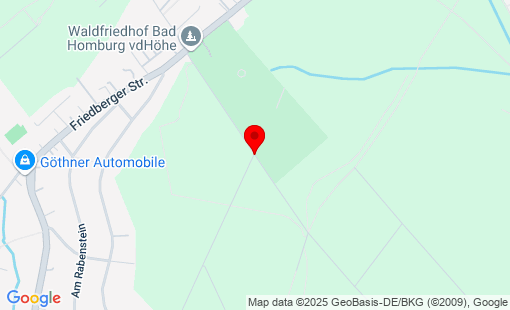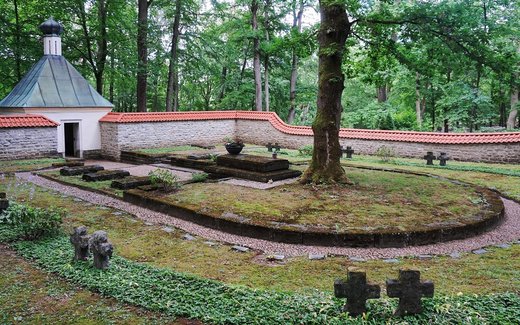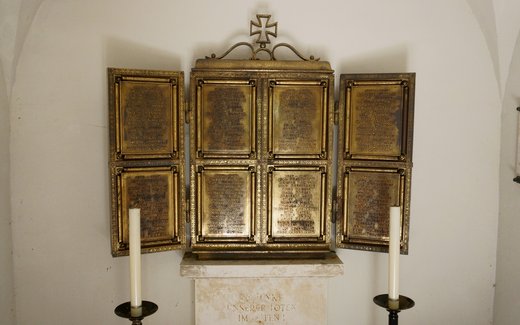Germany
Bad Homburg v. d. Höhe-Waldfriedhof
Total Occupation: 162 fatalities
Total Occupation: 162 fatalities
Open all year round
From the very beginning, the forest cemetery, which was established by the town of Bad Homburg v. d. Höhe in 1920-1922, contained a burial site for 19 war dead from the First World War who had died in Bad Homburg's military hospitals. During and after the Second World War, other war dead were buried in the vicinity of this site: mainly German soldiers and civilian victims of the air war, but also the former Soviet prisoner of war Alexei Danilov. He died in June 1945 as a result of a gunshot wound. in 1949, the number of war graves in this part of the forest cemetery had grown to 135. In 1949, the Volksbund began to redesign the site, which was given its current structural form. The initiative came from the Volksbund's federal construction management in Munich, even though the Hessian state association was the client. The design for the redesign came from Robert Tischler, the Volksbund's chief architect from 1926 to 1959. Tischler envisaged developing the Bad Homburg war cemetery into a showpiece - in his own words: "a dominant feature of the building activity" - of the Volksbund in Hesse. The redesigned cemetery was inaugurated in 1951. A new grave was also created for Alexei Danilov. Today, it is no longer possible to determine whether the later burial of another war dead - Waffen-SS General Karl v. Treuenfeld - was already planned during the redesign of the site. It is also unclear what role the Volksbund played in this. Karl v. Treuenfeld had committed suicide in 1946 while in US captivity in Allendorf (now Stadtallendorf) and was initially buried there. In September 1954, Karl v. Treuenfeld's mortal remains were moved to the war cemetery at the Waldfriedhof. However, there was no family or biographical connection to Bad Homburg v. d. Höhe. According to the cemetery administration's account book, the deceased's daughter bore the costs of the reburial. A letter from Karl v. Treuenfeld's widow from 1963 has been preserved in which she thanked the Volksbund "for the burial at the time and for the constant care of the grave at the Waldfriedhof near Homburg v. d. Höhe". This suggests that arrangements were made prior to the reburial, but apart from the letter itself, no other sources have been found in the Volksbund archives from which the process could be reconstructed. It is noticeable, however, that the letter was not addressed to the state association of Hesse, but to the federal office of the Volksbund. A bronze "shrine of honour" was made for the chapel at the front of the redesigned cemetery in 1951. It takes the form of a three-winged altarpiece divided into eight sections. Panels are mounted in the fields, on which the names of the dead are listed in alphabetical order. Because it became apparent after just a few years that many of the names were misspelled, the shrine was completely reworked in 1959 in the workshops of the Federal Construction Office in Munich. A photograph from 1951 shows that the shrine originally had fewer than the eight name plaques it has today. The lower field in the right wing was left blank. The list of the dead ended with the name of Hugo Wolzenburg, the last in the alphabetical order. The panels were redone during the revision. The alphabetical order was retained, only Karl v. Treuenfeld's name was added out of sequence at the bottom of the last panel. Four other German war dead, who had only been transferred from the civilian part of the Waldfriedhof to the war cemetery in 1956, were no longer included in the list of the dead on the "Shrine of Honour". Alexei Danilov's name was also omitted. Karl v. Treuenfeld was born in Flensburg in 1885. At the age of 13, he began training as a professional officer at the Prussian cadet academy in Plön. He took part in the First World War in various roles as a front-line and staff officer, was wounded several times and was highly decorated. He left the Weimar Republic's "Provisional Reichswehr" in 1920 with the rank of major. His close relationship with Erich Ludendorff dates back to the war years. From 1920 to 1939, Karl v. Treuenfeld was active in the business world, as well as in paramilitary "völkisch" associations in northern Germany until 1924. in 1929, he went bankrupt with an import company, for which he blamed the "hatred of Jewish and Masonic business circles towards me". In 1939, Heinrich Himmler appointed him to the SS with the rank of SS-Oberführer. He was initially a leader in the staff of the "SS Totenkopfstandarten", which were deployed to guard the concentration camps, and later held numerous other positions within the SS. His personnel file lists a total of 17 different assignments up to 1945, several of which were only short-term: - 1.5.-1.9.1939: Leader in the staff of the SS Death's Head Guard - 1.9.1939-15.5.1940: Chief of Office in the SS Personnel Main Office - 15.5.-6.6.1940: Inspector of the SS Junker Schools - 6.6.1940: Commanded to the SS Disposal Division - 9.11.-28.11.1940: Leader in the Staff of the SS Disposal Division - 28.11.1940-11.4.1941: Chief of the Office for Führer Training in the SS-Führungshauptamt - 11.4.-1.12.1941: Commander of the Waffen-SS, Northeast - 1.12.1941-4.7.1942: Commander of the Waffen-SS in the Protectorate of Bohemia and Moravia - 4.7.1942-1.2.1943: Commander of the 1. SS-Infanterie-Brigade (mot) - 1.2.1943-30.1.1944: Commander of the Waffen-SS in the area of the Higher SS and Police Leader Russia-South - 30.1.-1.5.1944: Commander of the 10th SS-Panzergrenadierdivision "Frundsberg" - 1.5.-24.5.1944: Führerreserve of the SS-Führungshauptamt - 24.5.-21.6.1944: Deputy Commander in the General Command of the VI SS Volunteer Army Corps - 21.6.-15.7.1944: Commanding General of the VI SS Volunteer Army Corps - 15.7.-1.8.1944: Führerreserve of the SS-Führungshauptamt - 1.8.1944-10.1.1945: Inspector (of the SS armored troops) at the SS-Führungshauptamt - From 10.1.1945: Führerreserve of the SS-Führungshauptamt As commander of the Waffen-SS in the "Protectorate of Bohemia and Moravia", Karl v. Treuenfeld commanded the pursuit of the assassins and the attack on the Prague church in which they had been hiding after the attack on the deputy "Reich Protector" Reinhard Heydrich in 1942. As commander of the 1st SS Infantry Brigade, he was directly involved in the murderous warfare against the Belorussian and Jewish civilian population in the area of Army Group Centre in the summer and autumn of 1942. During his deployment as commander of the SS "Frundsberg" armored division, he was promoted to SS-Gruppenführer and lieutenant general of the Waffen-SS in January 1944. Although an appointment as commander of the Waffen-SS with the "Highest SS and Police Leader Italy" from June 1944 is documented in the personnel records, this assignment was not entered in the service career. Instead, Karl v. Treuenfeld is listed as Commanding General of the VI SS Volunteer Army Corps for this period. In the final months of the war, he was temporarily assigned to the "Führer Reserve" of the SS Leadership Main Office as a temporarily unoccupied officer for the third time since 1944, which corresponded to a temporary transfer to retirement. In May 1945, he was captured by the US Army in Bavaria. As a prisoner of war, Karl v. Treuenfeld was last interned in the "Steinlager" in Allendorf, Hesse, a collection camp for German generals and general staff officers. He was interrogated here on March 6, 1946 by Lieutenant Alfred E. Laurence of the US Army's War Crimes Investigation Team 6823. Laurence, a German emigrant and former prisoner of the Sachsenhausen and Dachau concentration camps, informed v. Treuenfeld that he was wanted by the USA on suspicion of war crimes and that the Soviet Union was demanding his extradition. Karl v. Treuenfeld hanged himself the following night. He was buried in Allendorf on March 9, 1946. As Karl v. Treuenfeld died as a prisoner of war before March 31, 1952, his grave also counts as a war grave in accordance with the provisions of the Law on the Preservation of the Graves of Victims of War and Tyranny ("Graves Act"). The law stipulates that these graves must be maintained from public funds for an unlimited period of time and may not be removed. Traditionally, the Volksbund indicated the rank of the dead on war graves if German military personnel were buried in them. However, when the Hessian regional director asked the Federal Construction Office in Munich to make a gravestone for Karl v. Treuenfeld in 1954, he omitted the rank. When the gravestones were replaced in 1959 - the original ones had soon become illegible and were replaced by plinth stones with bronze plaques - Karl v. Treuenfeld's name was given a rank. Treuenfeld's name was given a rank, but now in the misleading shortening of the full designation "SS-Gruppenführer und Generalleutnant der Waffen-SS" to "Generalleutnant". The fact that Karl v. Treuenfeld had belonged to the SS was thus made unrecognizable. To this day, the incomplete indication of rank gives the impression that a general of the Wehrmacht is buried here. The war cemetery at the Bad Homburg v. d. Höhe forest cemetery was examined for the first time in 2019 by the state association as part of its historical research project. At that time, the background to Karl v. Treuenfeld's reburial was initially to be determined from the sources available at the Volksbund itself. This was followed by research at the Federal Archives in Berlin and the Documentation and Information Center (DIZ) in Stadtallendorf. In 2020, it was also possible to evaluate the collection of material on the v. Treuenfeld case, which was compiled by an employee of the Bad Homburg v. d. Höhe municipal archives. The results presented here represent an interim status. The war cemetery at the Waldfriedhof was selected in July 2020 as the next research focus of the regional association. Further research is planned for the current year, with a particular focus on the fates of other dead at the cemetery.



